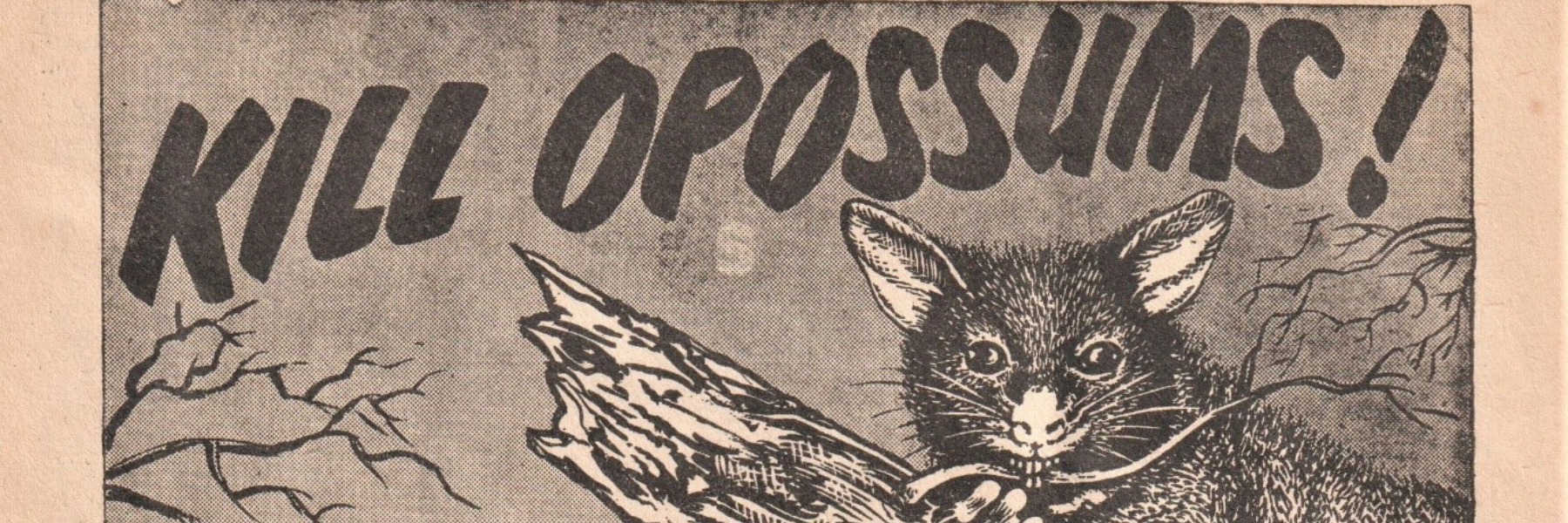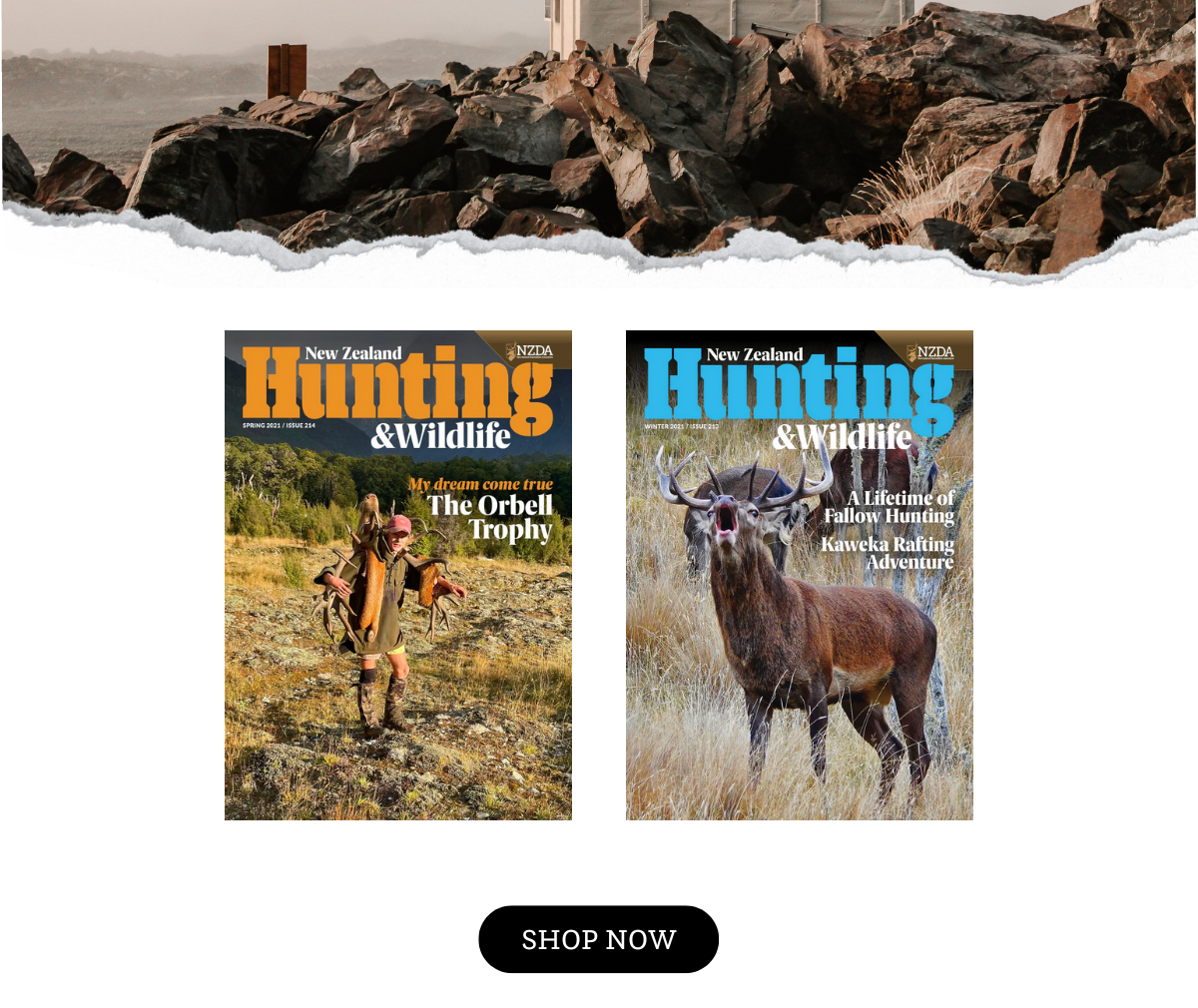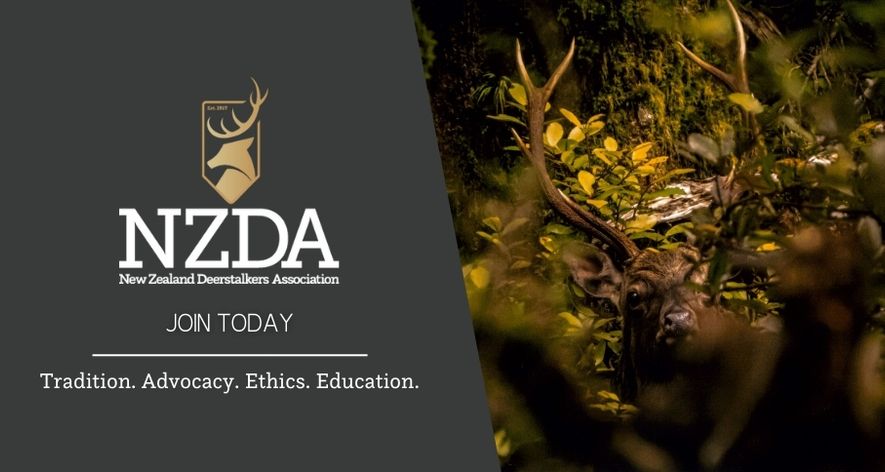Possums in New Zealand
Hunting and Wildlife Magazine - Spring Issue 222
Words By: Keith Mitchell
The brushtail possum (Trichosurus vulpecula) was introduced into New Zealand from the Australian mainland and Tasmania, to create a fur industry for the settlers. The first recorded successful liberation in New Zealand was in 1837 at Riverton, Southland. There followed 38 further liberations from Australia by private individuals and the Acclimatisation Societies, the last being in 1898.
There are 23 known species of possum in Australia. The brushtail species which was brought to New Zealand, included eight subspecies varying in size and colour, which I guess accounts for the variations we see in possums here. The main breeding season occurs in April/May with normally one young raised per year. In Australia, all possum species are protected as they are native to The Great Southern Land and its surrounding islands.
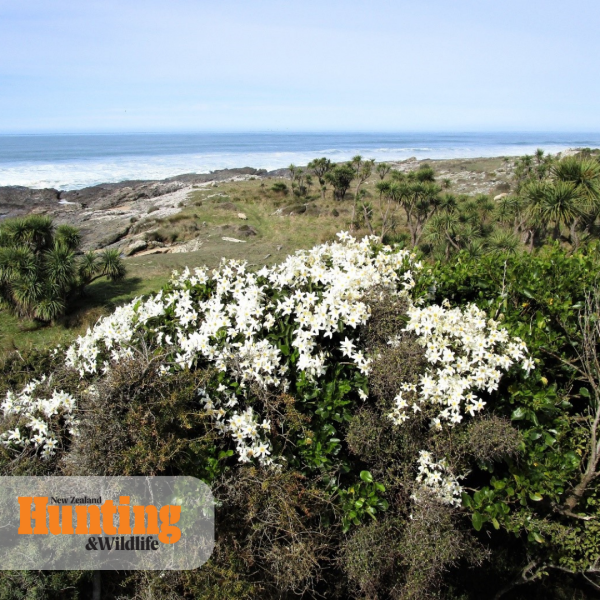
The foreshore between the paddocks and the sea is great habitat for possums with dense mats of Muehlenbeckia which they love. They are particularly fond of the fresh growth in spring.
There are several species of American possum, the only marsupials native to countries outside Australasia. They are plain-looking critters that only their mothers could love. I guess they must have originated from common ancestors of our possums during the time of Gondwanaland, before the continents split apart. The South American continent was part of that huge southern landmass and possums would have spread from there into North America across the land bridge.
By the turn of the century, New Zealand fruit growers were becoming rather irate about the damage being done to their crops by possums, but it took until 1919 before the Government requested H. B. Kirk, Professor of Botany and Zoology at Victoria University, to study the situation. His 1919 findings: ‘’The damage to New Zealand forests is negligible and is far outweighed by the value in skin sales for the community’’. The fruit grower’s losses of hundreds of pounds were outweighed by the present trade in skins in the thousands. Further, in his opinion: ‘’Opossums may, in my opinion, be liberated in all forest districts except where the forest is ringed by orchards’’. Apart from the underestimate of native forest damage, there was no knowledge of what possums were doing to our native birds. The report strongly influenced subsequent legislation.
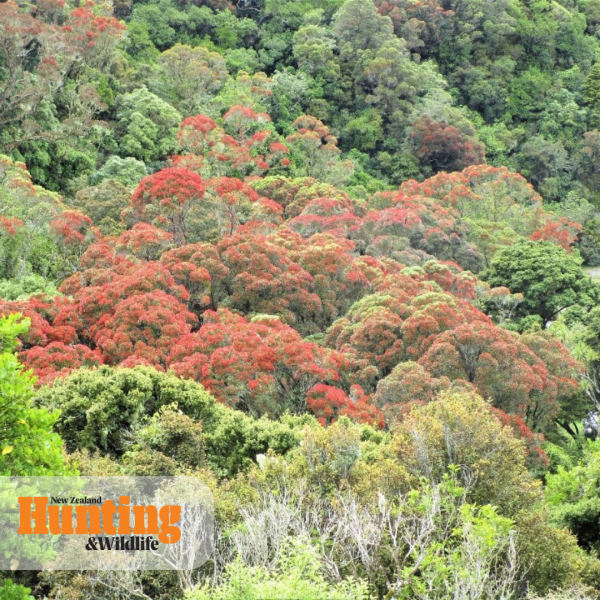
Southern Rata in the gorge flowering during January 2021. Apparently, it has been shown that one possum feeding on a Rata or Pohutukawa continuously can kill the tree in a couple of years.
Coincidentally, an item in the ‘100 Years Ago’ column in the Otago Daily Times from the April 29, 1919, issue caught my attention. It read ‘’At a meeting of the Board of Agriculture yesterday, a lengthy report on the proposal that opossums might be liberated in some forests of the great alpine range was carefully considered. It was finally agreed that this might prove a considerable source of revenue to the country if every care was taken to prevent their introduction into districts where they might become a menace to the fruit growing industry. ODT, 29.4.1919’’. It makes one wonder how the worthies who were considering the lengthy report (presumably that of Professor Kirk) were not able to figure out that possums would sooner or later find their way everywhere including to where all fruit trees were growing.
Believe it or not, in 1921 regulations, which included the requirement for licences, were laid down for the taking of possums – it still was not ‘open slather’. Liberations were still allowed by written consent from the Department of Internal Affairs until 1922 when all legal liberations were terminated. There were a great number of unauthorised releases for another 20 years and it was not until 1947 that all restrictions were removed for the taking of possums.
The Department of Internal Affairs was not satisfied that unregulated possum hunting would control numbers. Therefore, the department embarked on a nationwide programme of field research to survey the effect possums were having on our forests. This showed that more positive action was required, so a bounty of 2s/6d was paid for each possum killed on the presentation of a token. This token was the ears attached to a strip of skin down the back which meant that the person killing possums could not both claim the half-crown and sell the skinned pelt – it was either one or the other. In 1956, possum control was passed to the New Zealand Forest Service. In 1960, the bounty was removed.
Back in 1992, I began seriously trying to reduce the populations of hares and possums on the farm we owned, and on the farm we leased, which are almost adjoining properties. Here is a tabulation of the results for possums (I always knew that I would find a use for these records eventually) for usually about four nights shooting annually.
|
1992 |
147 |
2000 |
10 |
2008 |
2 |
2016 |
30 |
|
1993 |
91 |
2001 |
5 |
2009 |
1 |
2017 |
24 |
|
1994 |
22 |
2002 |
1 |
2010 |
0 |
2018 |
62 |
|
1995 |
33 |
2003 |
3 |
2011 |
0 |
2019 |
53 |
|
1996 |
38 |
2004 |
0 |
2012 |
0 |
2020 |
54 |
|
1997 |
58 |
2005 |
0 |
2013 |
0 |
2021 |
85 |
|
1998 |
58 |
2006 |
0 |
2014 |
2 |
2022 |
116 |
|
1999 |
47 |
2007 |
0 |
2015 |
6 |
2023 |
115 |
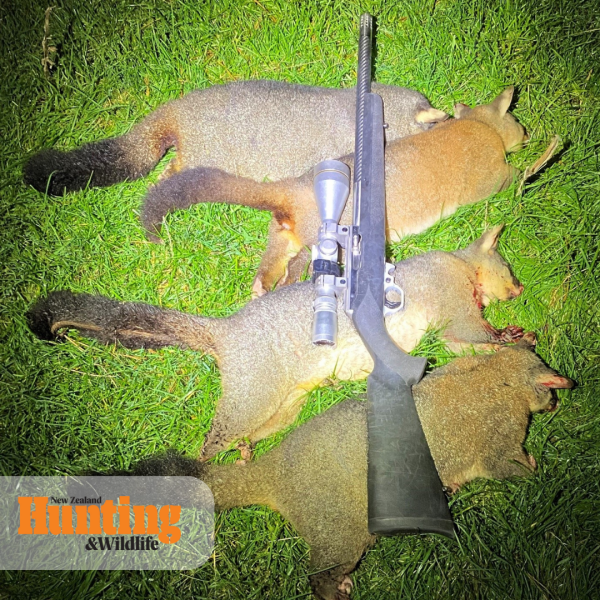
Three greys and a light brown. These four were very obliging, feeding out on the grass together and close to the bush edge, four shots and four dead possums. Four is about as many as I can comfortably pluck at one time because the bodies quickly cool off and become more reluctant to give up their fur.
As can be seen, there were a lot of possums in the beginning and that after a couple of years, I had reduced numbers considerably, but I was still shooting around 50 per year. By 2000, our export markets were grumbling about Bovine Tuberculosis and the Ministry of Agriculture was getting seriously alarmed at the numbers of cattle herds affected by TB for which the possum was a known vector for. Someone came up with the bright idea that largely amateur possum hunters employed by Taskforce Green be given the job of reducing possum numbers to try and control Bovine TB. While they certainly made an impact as can be seen in my table, the Animal Health Board decided to get properly serious about possums a year or two later and professional pest destruction companies were let loose on them. They poisoned our property and those surrounding us and really cleaned the possums out. Notice that in the 15 years from 2001 to 2015, I struggled to find even one possum to shoot – of course, I was still shooting plenty of hares during the nights that I was out spotlighting.
The numbers of TB reactors in cattle and deer herds around New Zealand dropped dramatically due to this AHB effort in the early 2000’s and so as is typical in this country, the proverbial foot was lifted off the throat of the possum. To be fair, it was probably decided that it was not economically possible to eliminate residual possum populations with present technology. However, as can be seen, possum numbers in recent years have boomed and in the case of the two smallish farms where I have attempted a modest control effort, numbers are back to where they were in the 90’s. Note a steady increase in possum kills in the table from 2016 until the present day.
The first consequence we noticed of the greatly reduced possum numbers in the early 2000’s was the corresponding dramatic increase in birdlife. No tuis had been seen on our farm for 50 years. First one tui appeared and within a few years there were flocks of them. The same with native pigeons. I have put the reason for the increase down to the relatively heavy weights of both these birds. They both need to nest on strong branches making their eggs and nestlings accessible to possums. However, because these birds are large, they are more noticeable, and I am sure all bird species benefitted. Of course, they are now under threat from the increasing possum population.
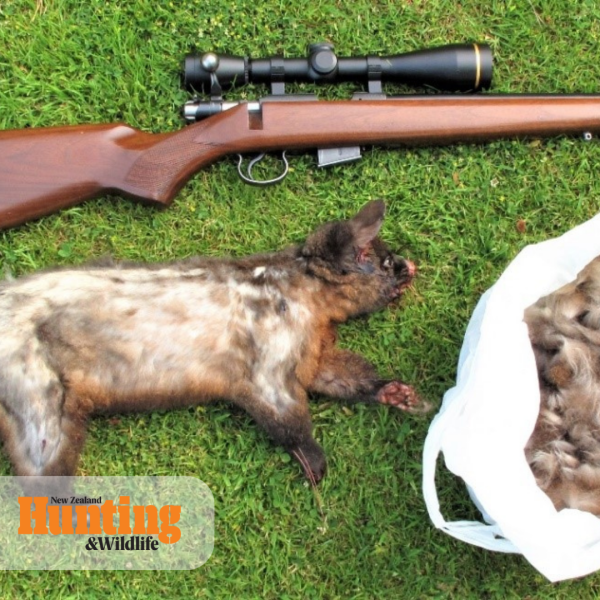
A plucked possum that did not give up its fur easily, they pluck cleanly when warm but as they cool it becomes a lot harder. The rifle is a deadly-accurate CZ 452 American in .17 HMR, the heavy-barrelled version.
Over the last 30 years, I have really looked forward to those spotlighting nights on the farm. I found the best part of the year to do this was in the late autumn. By then, most paddocks were empty of stock, our lambs had gone to the freezing works, our hoggets were being break-fed on swedes, and our ewes being strip-grazed around our grass paddocks. I would pick mild nights with a forecast minimum of 10 C and no moon. In the early days, I would use a separate spotlight, but I found that tricky, trying to line up a possum or hare through the telescopic sights while holding the spotlight, one needed to be a contortionist. Then I mounted a spotlight on top of my scope, but as I got older, I found swinging the rifle around all night rather tiring. The last few years, I have been using a head-torch, specifically a Ledlenser H15R Core, not cheap but very effective. It is rated at 2,500 lumens. The only difficulty is positioning the light on your head so that it lights up the subject in the scope. I found that a battery charge would last about five hours, enough for a night’s spotlighting.
In our part of South Otago, one of the favourite foods for possums is Muehlenbeckia australis (pohuehue) which despite the name, is a native prostrate or climbing plant. To quote from Wikipedia: “The flowers are greenish and the fruits are juicy with black shiny seeds covered by a white, succulent cup of sepals, which are fed on by various birds and lizards. Flowers bloom from late spring to autumn, while panicles occur usually in spring and summer. Fruits are present from November to April, sometimes till June”.
The above explains why possums can be found in Muehlenbeckia pretty much all year round. A good third of the possums I would shoot, were in Muehlenbeckia. However, possums will happily consume a long list of New Zealand native foods, not least of which are totara berries. Each of the gullies that run down to the sea on our coastal property, has stands of totara so I’ve shot quite a lot of possums in those trees. Most of the rest were grazing grass or swedes.
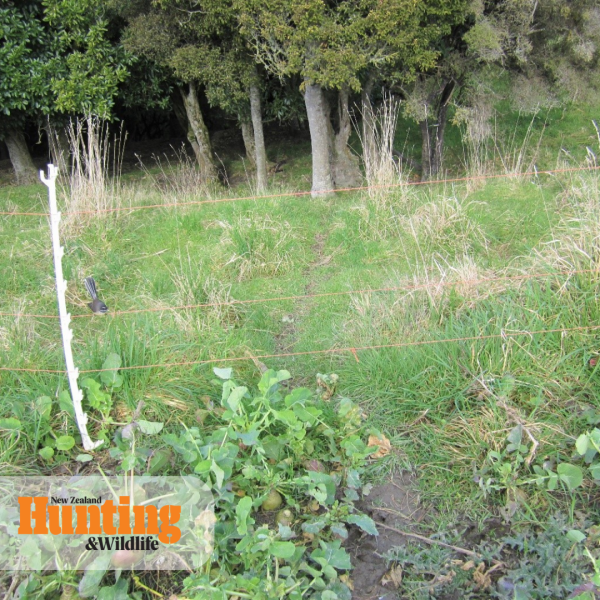
A well-defined track coming out of the native gorge for possums to dine on our swedes. I shot and plucked 15 possums one night close to this track in the swede crop.
Bruce Masson, who has shot, trapped, poisoned, and skinned about a zillion possums in his time, had previously introduced me to plucking possums. This was on freezing mid-winter nights spotlighting on a Central Otago station. Bruce would do both the driving and the spotlighting by reaching out the driver’s side window of his Hilux searching with his powerful Lightforce spotlight. Meanwhile, I sat in the front passenger’s seat, cradling my .22 ready to pop off any rabbits, hares, or possums that appeared. Whenever I shot a possum, Bruce would stop the truck, jump out, fetch a large plastic bag part-full of fur from the back seat, and proceed to furiously pluck the possum while I held the torch. Spurred on by the thought of a hundred dollars per kilogram, Bruce had plucked so many possums over the preceding months that the skin on his fingers was covered in stinging cracks.
The buyers of the fur, to be blended with merino wool for knitting nice warm and soft jerseys, do not really want the short belly fur, and certainly not the wiry tail fur. Those hunters who use a mechanical “plucker” get paid less for their fur. This is compensated for by the hunter not being restricted to plucking fur from warm bodies, the mechanical plucker will do a clean job on very cold possums. There is also a market for head-shot possums as pet food.
The omnivorous eating habits of possums was proven to me many years ago when Bruce and I were spotlighting on a giant sheep and cattle station. The paddock we were in had been grazed hard, the ground was quite bare. Bruce played the light on a flat sheep carcass, he thought he had spotted movement. Sure enough, the burning-coal eyes of a possum stared back at us. After I despatched it, Bruce drove us over to it. It was a huge black possum, the largest I have seen before or since. Upon inspection, we could see that it had been inside the hollow sheep carcass, stripping and eating the layer of fat from the inside of the ribs. Food for thought.
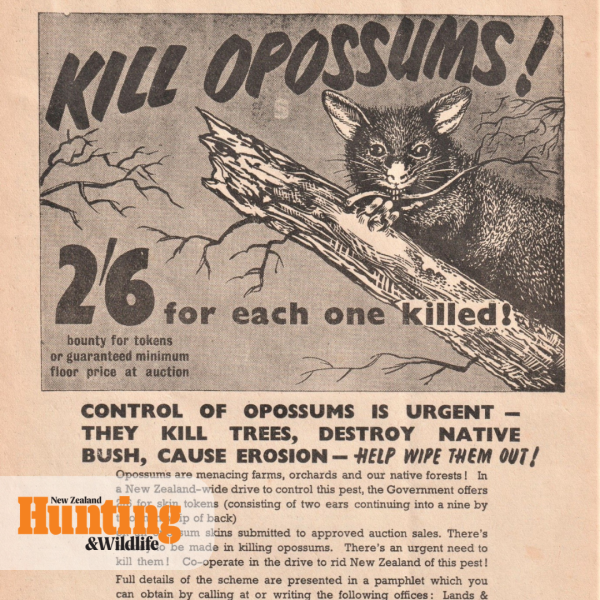
A rather desperate plea from the Wildlife Division in the July 1954 issue of the New Zealand Fishing & Shooting Gazette.
With our farming days drawing to a close this year, I was determined to get out on the farm for a few nights spotlighting, my last chance. We had a run of frosty nights in June, then a week when the frosts relented before it started to rain and snow. I got out on four nights during the period between frost and rain. It was not tropical, and the temperature was generally below my 10 C minimum, mainly because a foul nor ‘east wind blowing constantly. The north side of clumps of grass were dry, and the south side melted ice. Conditions less than perfect but the nights were very enjoyable.
I did have a minor “off” on the first of my four nights this winter. I shot a possum at the bottom of a gully, so I rode my quad down to pick it up and place it on the tray for plucking in a more convenient spot. When I came to ride out of the gully, I carelessly chose an awkward path with the result that the quad rolled on to its side, dumping me, my rifle and the possum off and trapping my left foot. The quad’s engine choked off after a few seconds. I tried to pull my foot out, but it was trapped, crushing my toes. I am now a phone person (never thought I would be) and I could have got it out of my pocket and photographed my predicament, but it was not the first thing that came to mind. Anyway, I was able to push the quad up a little with my right foot and release my left – which is still rather tender and was able to continue my night’s hunt.
When possums are feeding on grass, it is nearly always close to cover which means that they are very often not feeding on the best grass which is at the top end on a paddock which slopes down to forest or bush cover. Sheep do not like eating grass in such places, so it tends to become rank, but the possums don’t seem to mind.
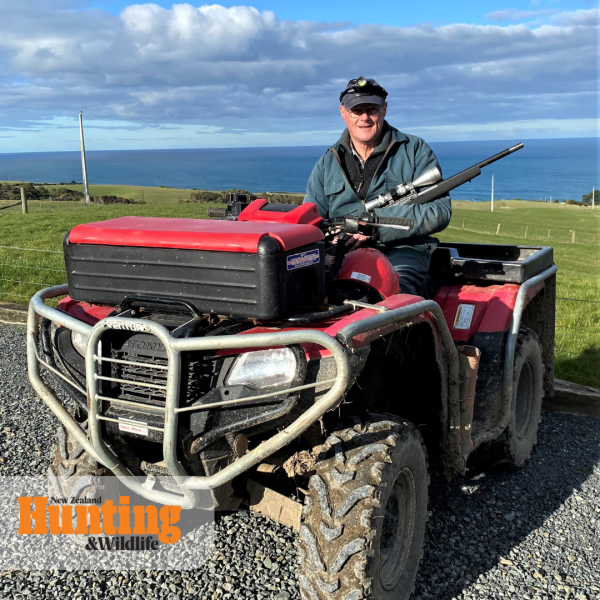
The author, Keith Mitchell
Body shots on possums do not reliably kill them quickly - they are tough. If body-shooting them in the above situation close to a bush edge, they will often make it to impenetrable cover. On several occasions over the years, I have flattened a possum with a shot, then looked down to reload or place my rifle back on its rack, then looked up to see that the possum has disappeared. Best method for killing possums is to head-shoot them. You generally have two bright red eyes to aim at. That is where my Volquartsen comes in. The Volquartsen uses Ruger 10/22 magazines, in fact the receiver and bolt are clones of the 10/22 but made from stainless steel rather than aluminium alloy.
As the night advances and you have shot a few possums, your hands become a little bloody when plucking which causes fur to stick to them. It is important to wipe your hands to remove as much fur as possible before reloading the magazine of a self-loading .22. Fur transferred to the cartridges is bound to lead to jams.
One night’s shooting yields a kilo or so of possum fur – a bloody lot of plucking which slows up the shooting. I lay it out on the shearing shed board to dry, especially if it has been a very dewy night. Fur will go mouldy and be unsaleable if it is not dried. The buyers are not concerned about the mix of colours. This year I sold 9.64 kg of fur (I had quite a bit left over from last winter) at $100 per kg, for a total of $964. I am pleased to say that as always, I do not waste a cent, it all goes towards buying more collectible firearms.

